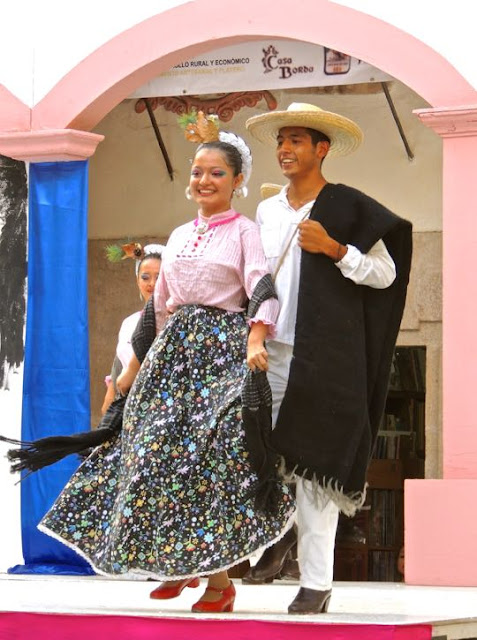Dancers in traditional costumes whirl and stomp on a stage in Taxco's Plaza Borda. While visiting Plaza Borda, we stumbled across a free public performance of a baile folklorico (folkloric dance). Hundreds, perhaps even thousands, of similar dance troupes perform regularly all over Mexico. While some are made up of salaried professionals, others come from small towns. The local troupes often include children and older people among their performers. Even the amateurs are fun to watch and there are several of these groups in the Lake Chapala area where we live. The baile folklorico troupe above is from Taxco and they are quite good. The performers regularly changed into the regional costumes of the areas where particular dances originated. In this short posting, you'll see the dancers in action and I'll provide a bit of the history of the art form.
Beautifully embroidered costumes are part of a dance from Mexico's Gulf Coast area. The music and instruments used for particular dances are also typical of that region, in this case marimbas. Folk dances have been popular among Mexico's common people for hundreds of years. Some even date back to the pre-hispanic era. However, until the 1910 Revolution, the culture of commoners was generally ignored, if not disparaged, by the society's elites. "Well-bred" people were focused on Spanish culture during the colonial and early post-colonial era. During the last part of the 19th century and the beginning of the 20th, everything French was the height of fashion.
A pair of dancers strut their stuff. The embroidered white outfits of the performers are typical of the Gulf Coast and Yucatan. The great popular uprising known as the Mexican Revolution refocused attention on indigenous people and common folk in general. Revolutionary leaders like Pancho Villa and Emiliano Zapata came from humble origins as did many others. The Revolution brought an ideological shift away from Europe and toward Mexico's roots. The broad public interest in pre-hispanic glory and Mexico's popular culture was viewed by Revolutionary leaders as a way of uniting a shattered country.
The couple above are attired much like the country people of previous centuries. Men wore home-spun white cotton pants and shirts. They carried serapes, which are folded blankets worn over the shoulder. A head-hole is cut in the middle of a serape so it can be used either as a garment or a bed roll. Broad straw hats gave protection against the intense Mexican sun. Women wore full, ankle-length skirts, the more colorful the better. They tied their hair up in buns with ribbons and flowers.
Much of the dancing involved fancy footwork, a little like tap dancing. When the whole troupe danced together, they created a thunderous sound with the hard leather heels of their shoes. These kinds of drum-like dance steps are called zapateados. The Casa Borda cultural center, which sponsored the event, set up rows of chairs for the public. Many more people stood behind them to watch. One of the joys of Mexico is that there is so much free public entertainment. In most towns, the local plaza includes a cultural center. These tax-supported institutions promote art, music, and dance created or performed by members of the local community. People are encouraged to participate, not just as spectators but as performers.
The outfits above are typical of western Mexico, particularly of my home state of Jalisco. The vividly contrasting colors of the woman's dress remind me of the profusion of multi-colored flowers that blossom here year-round. The man is dressed as a vaquero (cowboy), wearing denim, leather boots, and a cowboy hat. This reflects a long tradition of cattle raising that dates back to the 17th century. In fact, Mexico's vaqueros invented the entire cowboy culture and technology 200 years before the first American cowboy pulled on his spurs.
The full, flowing skirts lend themselves to the dramatic twirls. The Jarabe Tapatio is one of the dances associated with Jalisco's capital, Guadalajara. El baile de los sonajeros (the rattle dance) is another Jalisco specialty. These dances are usually accompanied by mariachi music, which was born in Jalisco. Baile folklorico as an art form was invented in the 1950s by Amalia Hernandez. She established a school of folkloric dance in Mexico City and assembled a dance troupe called Baile Folkorico Mexico. Today, this troupe performs regularly in the Palacio de Bellas Artes in Mexico City. They also tour internationally. Several years ago, during a visit to Mexico City, Carole and I attended one of their spectacular performances.
In a dance about marriage, the bride and groom kiss. Baile folklorico is the antithesis of the winner-take-all, star-system which passes for public entertainment in the US. Baile folklorico encourages participation, even by some of the poorest pueblos. In the so-called First World, entertainment is all about glorifying a tiny elite who collect the Big Bucks. This star-system, promoted by TV, encourages a passive, couch-potato viewership. People become fans rather than participants. That there are well-paid, top-level troupes in Mexico is undeniable. However, the widespread participation in this art form by local dance groups makes baile folklorico an entertainment of, for, and by the people.
The "bride" twirls in her voluminous gown, ecstatic in her new status. Several times, as we passed through Plaza Borda on our way to somewhere else, we paused to watch these skilled performers. Each time, we saw a bit more of their repertoire and reflected on our good fortune to be here during a performance.
This completes Part 3 of my Taxco series. I hope you enjoyed it and, if so, that you leave any thoughts and questions in the Comments section below, or email them to me directly. If you leave a question in the Comments section, PLEASE leave your email address so that I can respond.
Hasta luego, Jim









No comments:
Post a Comment
If your comment involves a question, please leave your email address so I can answer you. Thanks, Jim